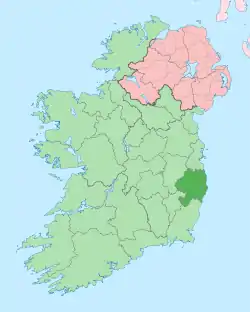Blessington
Blessington, historically known as Ballycomeen (Irish: Baile Coimín, meaning "town of Comyn", from the Irish surname Ó Coimín),[3] is a town on the River Liffey in Wicklow, Ireland, near the border with Kildare. It is around 25 km south-west of Dublin, and is situated on the N81 road, which connects Dublin to Tullow.[4]
Blessington
Baile Coimín | |
|---|---|
Town | |
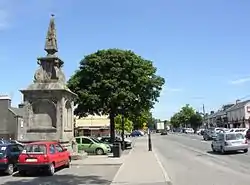 Marquis of Downshire's Memorial, Blessington | |
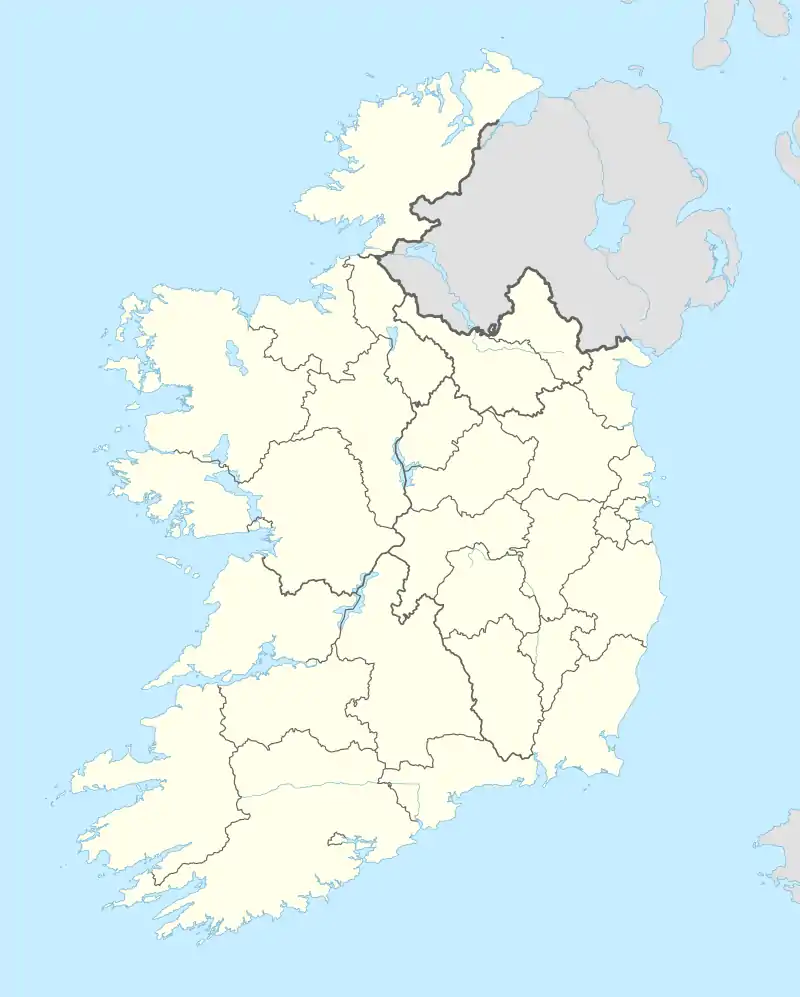 Blessington Location in Ireland | |
| Coordinates: 53.170°N 6.533°W | |
| Country | Ireland |
| Province | Leinster |
| County | County Wicklow |
| Elevation | 223 m (732 ft) |
| Population (2016)[1] | |
| • Urban | 5,520 |
| Irish Grid Reference | N976142 |
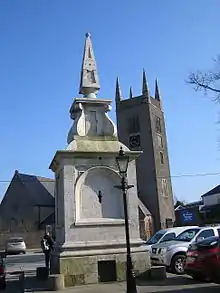

History
Prehistory
Evidence of Bronze Age activity in the area is demonstrated by the spectacular Blessington gold lunula, now in the British Museum.[5] The nearby Rath Turtle Moat was occupied from the 12th century onward by Norse Gaels and Normans.
Medieval period to 1800s
Blessington was previously called Munfine, and in the Medieval period was part of the lordship of Threecastles. In 1667, Michael Boyle (the younger), Archbishop of Dublin and Lord Chancellor of Ireland, bought the lordship of Threecastles, previously the property of the Cheevers for £1,000. Boyle received a Royal Charter to establish the town of Blessington, in the townland of Munfine, as a borough.
Construction of Blessington House was begun in 1673 and afterwards St. Mary's Church in Blessington, which was completed in 1683. On Boyle's death in 1702 his son Murrough Boyle, 1st Viscount Blesington and Baron Boyle, inherited the Blessington estate. Murrough's son, Charles, died in 1732 without an heir and the estate was inherited by his sister Anne, then her son William Stewart, 1st Earl of Blessington and Baron Stewart. Stewart died in 1769 without an heir and the estate passed to Charles Dunbar, a great grandson of Murrough Boyle, who also died heirless in 1778, when the estate passed to Wills Hill of Hillsborough, County Down, a great great grandson of Michael Boyle and the first Marquess of Downshire. The Hills held the estate until 1908.
Russborough House, situated 5 km south of Blessington, was built by the Leeson family, earls of Milltown, and became the home of philanthropist Sir Alfred Beit (1903–1994), before becoming a museum.
Modern development
Since the turn of the 21st century, Blessington's population has increased substantially, more than doubling from 2,509 at the 2002 census, to 5,010 by the time of the 2011 census.[6] The majority of housing estates were constructed on the western side of the town, off the R410, which is the road to Naas. A new inner bypass has also been opened that alleviates traffic on Main Street to some degree.
Infrastructure improvements since 2005 include a playground, fire station, a central retail development, including a Dunnes Stores outlet and a public library (opened in 2006) above it, expansion of a SuperValu supermarket, and addition of an ALDI supermarket.
Features
St Mary's Church
St Mary's Church is situated in Market Square, in the middle of the town. It was built around 1683, having been financed by Archbishop Boyle. While most of the church was rebuilt in the 19th Century, the tower of this old church remains at the west end.[7]
The church is well known in the bell-ringing community for housing the oldest complete set of bells in Ireland. The six bells date to 1682, and were cast by James Bartlet, who was the master founder of Whitechapel at that time. The money for these was also given by Archbishop Boyle. They are still rung twice a week, for Sunday morning service and on Saturday nights, for ringing practice.[8][9]
While it holds the oldest peal of change-ringing bells in Ireland, the oldest bells hung for change-ringing in Ireland are found in St Audoen's Church in Dublin city centre. Three of the bells (the 3, 4, and 5 of the 6 bell-peal) date to 1453, and were cast in York.[10]
Poulaphouca Reservoir
Also known locally as the Blessington Lakes, the reservoir was created when the waterfall at Poulaphouca on the River Liffey (which flows from the Wicklow Mountains to Dublin) was dammed by the ESB for a hydroelectric plant which is still in use today. The valley was flooded and the resulting lakes extend over approximately 5,000 acres (2,023 ha). A small village was submerged by the damming of the waterfall, and the remains of roads can still be seen leading down into the lake.
In addition to electricity, the lakes also provide water for the locality and the Dublin region as well as provide a leisure resource. There is now a lakeside luxury hotel complex in the Blessington area, with its own helipad, and lakeside facilities which has helped to develop tourism in the area. The lake is also extensively used by boatmen and fishermen, and is a training location for the Irish Air Corps HQ divisions from Baldonnel, 15 km north of Blessington, and also Local Civil Defence Water rescue teams.
Transport
In 1888, the Dublin and Blessington Steam Tramway service commenced from Terenure to Blessington via Tallaght, linking with the horse trams from the city.[11] This service ended at the end of December 1932 and was replaced with a conventional bus service, the 65, which still acts as the only public transport in the area to the city centre.
Bus Éireann, the national bus company, also provides a minor service, because Blessington is upon the N81. The R410 is another major road that connects Blessington with Naas. The route starts in the south end of the town heading west and proceeds up over the hills of Glending Forest and Eadestown. The road terminates in the Eastside of Naas as the Blessington Road. During the winter months the route is very treacherous during heavy snowfall and is sometimes closed in severe conditions.
Route 65, to Poolbeg Street in Dublin City Centre, passes through Rathmines, Terenure, Templeogue, Tallaght, and Brittas on its way to Blessington.[12] A limited number of daily services on route 65 are also extended further to Ballyknockan and Ballymore Eustace.[12] The Ballymore service routes via the N81, as does the Ballyknockan service.[12]
Route 3/5/132 (Dublin-Tullow) routes via Tallaght Hospital, Blessington, Baltinglass and Rathvilly en route to Tullow. One journey is extended daily to Rosslare Europort and Wexford.[13]
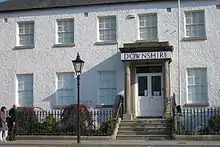
Education
The town and its hinterlands are served by several primary schools and one secondary school.
The local primary schools include St Mary's National School, a Roman Catholic national school, which comprises St Mary's Junior National School (infants to 2nd class) and St Mary's Senior National School (3rd to 6th class). As of 2019, the combined coeducational school(s) had over 600 pupils enrolled.[14][15] The local Church of Ireland national school is known as Blessington Number 1 National School, and had approximately 200 pupils enrolled in 2018.[16]
Gaelscoil na Lochanna (School of the Lakes) is a gaelscoil which was founded in 2006 to cater for those in the area who wished to educate their children primarily through the Irish language. As of 2018, it had 215 pupils enrolled.[17] A nearby Educate Together national school was founded in 2006 on the site of a long-standing school and has a large sports field.[18]
The only secondary school in Blessington, Blessington Community College, is on the Naas Road and had an enrollment (in 2019) of over 500.[19]
Notable people
The world-famous ballerina Ninette de Valois (née Edris Stannus) spent her childhood at Baltiboys near Blessington.[20] Lorenzo Moore, a noted Anglican clergyman in New Zealand, was born in Blessington in 1808.[21] Tour of Ireland race director John Lackey lived here until his untimely death.
References
- "Sapmap Area - Settlements - Blessington". Census 2016. Central Statistics Office. April 2016. Retrieved 30 March 2020.
- "Object: The Blessington lunula, museum number WG.31". British Museum.
'Description: Gold lunula. Flat sheet crescent of beaten gold with quadrangular terminals
- "Baile Coimín/Blessington". logainm.ie. Irish Placenames Database. Retrieved 30 March 2020.
- https://www.independent.ie/regionals/wicklowpeople/localnotes/blessington-bulletin-39111152.html
- "The Blessington lunula". British Museum. Retrieved 11 January 2018.
- "Blessington (Ireland) Census Town". citypopulation.de. Retrieved 30 March 2020.
- "Blundell House Additional Images: Buildings of Ireland: National Inventory of Architectural Heritage". www.buildingsofireland.ie. Retrieved 11 January 2018.
- "St Mary Blessington - BellringingIreland.org". www.bellringingireland.org. Retrieved 11 January 2018.
- "Bells at St. Mary's Church of Ireland are the oldest surviving set in the country Pealing the age-old bells of Blessington - Independent.ie". Retrieved 11 January 2018.
- "St Audeon Dublin - BellringingIreland.org". www.bellringingireland.org. Retrieved 11 January 2018.
- "Co. Kildare Online Electronic History Journal: BLESSINGTON TRAM - LAST RUN - NEW YEAR'S EVE 1932". www.kildare.ie. Retrieved 11 January 2018.
- "Dublin Bus - Route 65". Archived from the original on 4 November 2016. Retrieved 4 November 2016.
- "Timetable - Route 132" (PDF). Archived from the original (PDF) on 25 October 2012. Retrieved 15 February 2013.
- "St Mary's Senior National School, Blessington". education.ie. Department of Education. Archived from the original on 30 March 2020.
- "St Mary's Junior School, Blessington". education.ie. Department of Education. Archived from the original on 30 March 2020.
- "Whole School Evaluation Management, Leadership And Learning Report - Blessington 1 National School" (PDF). education.ie. Department of Education. 23 January 2018. Retrieved 30 March 2020.
- "Meastóireacht Curaclaim - Tuairisc - Gaelscoil na Lochanna" (PDF). education.ie (in Irish). Department of Education. 8 February 2018. Retrieved 30 March 2020.
- "History of Blessington Educate Together National School". educatetogether-blessington.ie. Retrieved 30 March 2020.
- "Subject Inspection - Report - Blessington Community College" (PDF). education.ie. Department of Education. 18 September 2019. Retrieved 30 March 2020.
- "Come Dance With Me – A Memoir 1898-1956". Lilliput Press. 2017. Retrieved 2 December 2017.
- Limbrick, Warren E. "Lorenzo Moore". Dictionary of New Zealand Biography. Ministry for Culture and Heritage. Retrieved 23 April 2017.
Further reading
- The Four Stone Tree: a history of Blessington by Vincent Byrne (self-published, 2003)
- The Blessington Estate 1667-1908 by Kathy Trant (Anvil Books, 2004)
External links
| Wikivoyage has a travel guide for Blessington. |
| Wikimedia Commons has media related to Blessington. |
